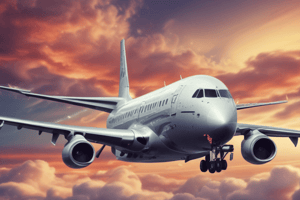Podcast
Questions and Answers
What is the maximum wing span for an aircraft to be classified as GROUP B?
What is the maximum wing span for an aircraft to be classified as GROUP B?
- 38.1 m
- 53.34 m
- 74.68 m (correct)
- 80 m
What is the equivalent wake turbulence category for GROUP A and GROUP G?
What is the equivalent wake turbulence category for GROUP A and GROUP G?
- Heavy
- Medium
- Super (correct)
- Light
When is the word 'Heavy' or 'Super' included in the initial radiotelephony contact between an aircraft and ATS units?
When is the word 'Heavy' or 'Super' included in the initial radiotelephony contact between an aircraft and ATS units?
- During the en-route phase of flight
- During the departure phase of flight
- During the approach phase of flight
- Immediately after the aircraft call sign (correct)
What is the recommended action for an aircraft that encounters wake turbulence of another aircraft en-route?
What is the recommended action for an aircraft that encounters wake turbulence of another aircraft en-route?
What is the minimum maximum certificated take-off mass for an aircraft to be classified as GROUP D?
What is the minimum maximum certificated take-off mass for an aircraft to be classified as GROUP D?
Study Notes
Wake Turbulence
- Wake turbulence refers to the effect of rotating air masses generated behind the wing tips of large jet aircraft.
Aircraft Categories
- Aircraft are grouped into four categories based on maximum certificated take-off mass:
- SUPER (J): specified in ICAO Doc 8643
- HEAVY (H): 136,000 kg or more, excluding SUPER category
- MEDIUM (M): less than 136,000 kg but more than 7,000 kg
- LIGHT (L): 7,000 kg or less
Wake Turbulence Groups
- Wake turbulence groups are based on wake generation and resistance characteristics:
- GROUP A: 136,000 kg or more, wing span ≤ 80 m but > 74.68 m
- GROUP B: 136,000 kg or more, wing span ≤ 74.68 m but > 53.34 m
- GROUP C: 136,000 kg or more, wing span ≤ 53.34 m but > 38.1 m
- GROUP D: less than 136,000 kg but more than 18,600 kg, wing span > 32 m
- GROUP E: less than 136,000 kg but more than 18,600 kg, wing span ≤ 32 m but > 27.43 m
- GROUP F: less than 136,000 kg but more than 18,600 kg, wing span ≤ 27.43 m
- GROUP G: 18,600 kg or less (no wing span criterion)
Radiotelephony Procedures
- For aircraft in the SUPER or HEAVY wake turbulence categories, the word "super" or "Heavy" is included in the initial radiotelephony contact with ATS units.
En-Route Wake Turbulence
- The effect of wake turbulence on other aircraft is not negligible during en-route phases of flight.
- Flight crews may request to proceed parallel offset of the airway by up to 2 NM to mitigate wake turbulence.
Studying That Suits You
Use AI to generate personalized quizzes and flashcards to suit your learning preferences.
Description
Learn about the wake turbulence effect behind large jet aircraft wing tips and the categorization of aircraft for take-off mass. Understand the ICAO specified SUPER (J) aircraft types.




